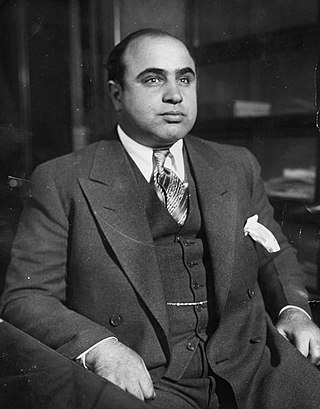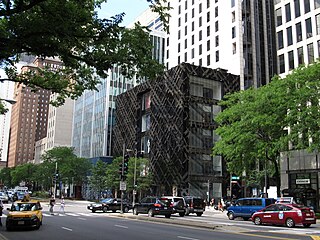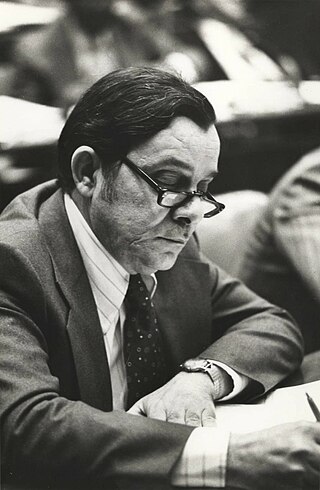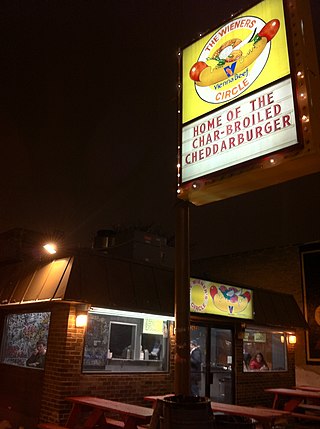| Lexington Hotel | |
|---|---|
 | |
 | |
| General information | |
| Completed | 1891/1892 |
| Demolished | 1995 |

The Lexington Hotel was a ten-story [1] hotel in Chicago at 2135 S. Michigan Avenue. [2]
| Lexington Hotel | |
|---|---|
 | |
 | |
| General information | |
| Completed | 1891/1892 |
| Demolished | 1995 |

The Lexington Hotel was a ten-story [1] hotel in Chicago at 2135 S. Michigan Avenue. [2]
The Lexington Hotel was built in 1892 (or 1891 [3] ) for attendees of the Columbian Exposition. [4] The hotel is notable for being Al Capone's primary residence from July 1928 until his arrest in 1931. [5] After the Saint Valentine's Day Massacre, some commenters called the hotel "Capone's Castle." [6] [7] It was later renamed "The New Michigan Hotel" and functioned as a brothel with 400 rooms. [3] The hotel closed in 1980. [4]
The hotel was featured on S7:Ep21 of This Old House . It was being renovated at the time.
On April 21, 1986, locked vaults found in the hotel were the subject of a live television program called The Mystery of Al Capone's Vaults , which received 30 million viewers. The building was demolished in 1995, despite its presence on the list of Chicago landmarks and the National Register of Historic Places. [8] [9] The location where the hotel once stood is currently the site of a 296 unit residential high rise called "The Lex" [10] that was completed in 2012.

Alphonse Gabriel Capone, sometimes known by the nickname "Scarface", was an American gangster and businessman who attained notoriety during the Prohibition era as the co-founder and boss of the Chicago Outfit from 1925 to 1931. His seven-year reign as a crime boss ended when he went to prison at the age of 33.

The Saint Valentine's Day Massacre was the murder of seven members and associates of Chicago's North Side Gang on Saint Valentine's Day 1929. The men were gathered at a Lincoln Park, Chicago, garage on the morning of February 14, 1929. They were lined up against a wall and shot by four unknown assailants, two of whom were disguised as police officers.

Rosemont is a village in Cook County, Illinois, located immediately northwest of Chicago. As of the 2020 census, the village had a population of 3,952. The village was incorporated in 1956, though it had been settled long before that. While Rosemont's land area and population are relatively small among municipalities in the Chicago Metropolitan Area, the village is a major center for commercial activity in the region and is a key component of the Golden Corridor. It contains the Allstate Arena, which hosts the Chicago Wolves AHL hockey team. Since its founding, the village has been governed by one family, and has been described as America's "last true political machine".

Eliot Ness was an American Prohibition agent known for his efforts to bring down Al Capone while enforcing Prohibition in Chicago. He was leader of a team of law enforcement agents nicknamed The Untouchables, handpicked for their incorruptibility. The release of his memoir The Untouchables, months after his death, launched several screen portrayals establishing a posthumous fame for Ness as an incorruptible crime fighter.

Michigan Avenue is a north-south street in Chicago that runs at 100 east on the Chicago grid. The northern end of the street is at DuSable Lake Shore Drive on the shore of Lake Michigan in the Gold Coast Historic District. The street's southern terminus is at Sibley Boulevard in the southern suburb of Dolton, but like many other Chicago streets, it exists in several disjointed segments.

Water Tower Place is a large urban, mixed-use development comprising a 758,000 sq ft (70,400 m2) shopping mall in a 74-story skyscraper in Chicago, Illinois, United States. The mall is located at 835 North Michigan Avenue, along the Magnificent Mile. It is named after the nearby Chicago Water Tower.

Earl J. "Hymie" Weiss, was a Polish-American mob boss who became a leader of the Prohibition-era North Side Gang and a bitter rival of Al Capone. He was known as "the only man Al Capone feared".

The Chicago Outfit is an Italian-American Mafia crime family based in Chicago, Illinois, which originated in the city's South Side in 1910. The organization is part of the larger Italian-American Mafia.

Alfred "Jake" Lingle was an American reporter for the Chicago Tribune. He was shot dead gangland-style in the underpass leading to the Illinois Central Randolph Street station on the afternoon on June 9, 1930, as dozens of people watched. The man convicted of the murder was mob associate Leo Vincent Brothers.
iO, or iO Chicago, is an improv theater and training center in central Chicago, with a former branch in Los Angeles, called iO West and in Raleigh, North Carolina called iO South. The theater teaches and hosts performances of improvisational comedy. It was founded in 1981 by Del Close and Charna Halpern. The theater has many notable alumni, including Amy Poehler and Stephen Colbert.

The Untouchables is a 1987 American crime film directed by Brian De Palma, produced by Art Linson, and written by David Mamet. It stars Kevin Costner, Charles Martin Smith, Andy García, Robert De Niro and Sean Connery. Set in Chicago in 1930, the film follows Eliot Ness (Costner) as he forms the Untouchables team to bring Al Capone to justice during Prohibition.

Giuseppe "Joe" Aiello was a Sicilian bootlegger and organized crime leader in Chicago during the Prohibition era. He was best known for his long and bloody feud with Chicago Outfit boss Al Capone.

The Mystery of Al Capone's Vaults is a two-hour live American television special that was broadcast in syndication on April 21, 1986, and hosted by Geraldo Rivera. It centered on the live opening of a walled-off underground room in the Lexington Hotel in Chicago once owned by crime lord Al Capone, which turned out to be empty except for debris. Thirty million viewers watched, making it the highest rated syndicated special in history.

Fred Bruno Roti was an American Democratic politician from Chicago, Illinois. He was a state senator for six years, and an alderman for 24 years. He was a loyal member of the "Machine" established by Mayor Richard J. Daley, and widely believed to be an associate of the Mafia. In 1993, he was convicted in Federal court of 11 criminal counts, and was sent to prison.
Ralph James Capone was an Italian-American mobster and an older brother of Al Capone and Frank Capone. He got the nickname "Bottles" not from involvement in the Capone bootlegging empire, but from his running the legitimate non-alcoholic beverage and bottling operations in Chicago. Further family lore suggests that the nickname was specifically tied to his lobbying the Illinois legislature to put into law that milk bottling companies had to stamp the date that the milk was bottled on the bottle. He was most famous for being named by the Chicago Crime Commission "Public Enemy Number Three" when his brother Al was "Public Enemy Number One".

Cermak Road, also known as 22nd Street, is a 19-mile, major east–west street on Chicago's near south and west sides and the city's western suburbs. In Chicago's street numbering system, Cermak is 2200 south, or twenty-two blocks south of the baseline of Madison Street. Normally, one mile comprises eight Chicago blocks, but the arterial streets Roosevelt Road, formerly named Twelfth Street and at 1200 South, and Cermak Road were platted before the eight-blocks-per-mile plan was implemented. Roosevelt Road is one mile south of Madison Avenue and there are twelve blocks within that mile. Cermak Road is two miles south of Madison Avenue and there are ten blocks within the mile between Roosevelt and Cermak Roads.

The Wieners Circle is a hot dog stand on Clark Street in the Lincoln Park neighborhood of Chicago, Illinois, United States. It is known for its Maxwell Street Polish, Char-dogs, hamburgers, cheese fries, and the mutual verbal abuse between the employees and the customers during the late-weekend hours.

Sixteen was an American restaurant on the sixteenth floor of the Trump International Hotel and Tower in the Near North Side community area of Chicago. It was one of three food and dining options in the hotel's room service offering. Sixteen opened in early February 2008, and an adjoining outdoor patio terrace, named The Terrace at T, opened on June 25, 2009 following the completion of the hotel's construction.

The Purple Gang, also known as the Sugar House Gang, was a criminal mob of bootleggers and hijackers composed predominantly of Jewish gangsters. They operated in Detroit, Michigan, during the 1920s of the Prohibition era and came to be Detroit's dominant criminal gang. Excessive violence and infighting caused the gang to destroy itself in the 1930s.

The 1924 Cicero, Illinois, municipal elections were elections held in 1924 to select municipal officers in Cicero, Illinois. The elections were notable for the gang-related violence which took place.
41°51′11.5″N87°37′24.0″W / 41.853194°N 87.623333°W